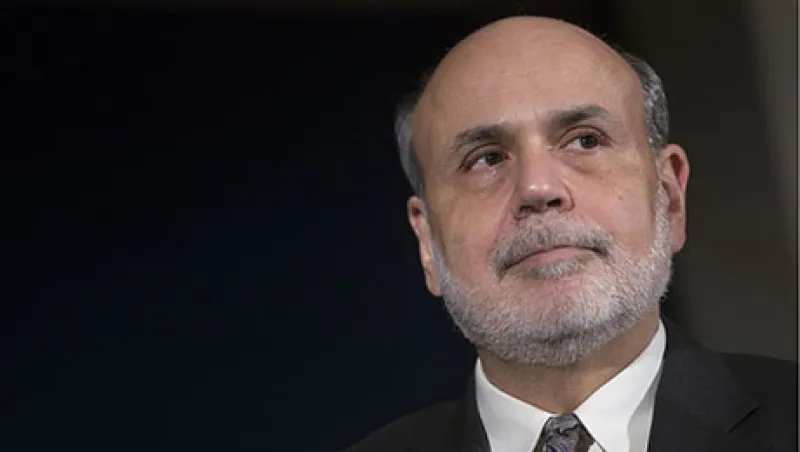Although markets had expected the Federal Reserve to begin scaling back its asset purchase program within the next few months, the timing of the announcement, December 18, came as a mild surprise. Despite the fact that the Fed took steps in its statement and in Fed chairman Ben Bernanke’s press conference to anchor short-term interest rate expectations, U.S. rates have drifted upward.
Even the two-year bond yield has edged higher, suggesting some skepticism about the Federal Open Market Committee’s forward guidance. In mid-2013 the Fed’s signal of a fairly imminent taper caused significant disruption in emerging-markets assets, with local bond yields, currencies and equities all selling off sharply. Investors will be paying careful attention to the emerging-market fallout from the decision to taper.
So far, emerging markets have reacted with moderation. The most significant move has occurred in the belly of local yield curves, where, as chart 1 shows, rates have increased about 8 basis points on average. That matches developments in the U.S., where medium-term yields have jumped in recent days, probably related to the unwinding of carry trades; see chart 2. In the U.S. longer-term rates have climbed less sharply, though some differentiation between low-yielding and higher-yielding (and presumably more vulnerable) emerging-market countries has taken place; see chart 3. Emerging-market foreign exchange generally has been stable, as shown in chart 4, even in currencies that came under fire earlier in the year. Emerging-market equities failed to follow U.S. stocks higher in the wake of the Fed announcement, further widening 2013’s underperformance; see chart 5. However, in absolute terms, emerging-market equities have only edged down.
Chart 1: 10-Year Swap Rates (%)
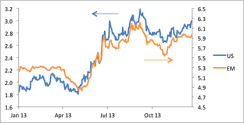
Source: Bloomberg, JPMAM; date through December 20, 2013
Chart 2: 5-Year Swap Rates (%)
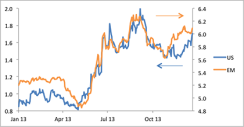
Source: Bloomberg, JPMAM; data through December 20, 2013
Chart 3: 10-Year EM Swap Rates (%)
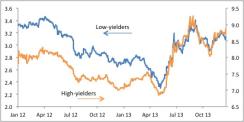
Source: Bloomberg, JPMAM; data through December 20, 2013
Chart 4: JPMorgan EM FX Index
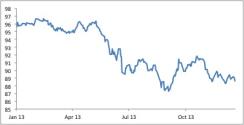
Source: Bloomberg; data through December 20, 2013
Chart 5: MSCI EM Equity Index, Level and Relative to S&P500
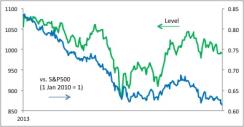
Source: Bloomberg, JPMAM; data through December 19, 2013
Relative emerging-market stability, in comparison with the near panic observed in May and June, when Bernanke first introduced the possibility of a taper, probably stems from several factors. First, the announcement from the Fed in Decemberwas much less a surprise than Bernanke’s speech in May. Second, markets had already moved significantly, both in the U.S. and the emerging markets. In some cases those earlier emerging-market swings may have helped reduce previous vulnerabilities. In India and Turkey, for example, external imbalances appear to have begun narrowing in response to currency depreciations. Third, global growth picked up recently, improving the fundamental backdrop of emerging-market economies, although the news out of the emerging world has been less unambiguously good than in the U.S.
The full story of the emerging-market response to the Fed shift likely will unfold only over time. In particular, and assuming that the Fed remains relatively more hawkish than other central banks, rate differentials that gradually move in favor of the U.S. dollar could promote gradual but lasting weaknesses in emerging-market currencies. With inflation generally running at or above target levels, emerging-market central banks might ultimately feel compelled to resist foreign exchange depreciations by raising short-term rates, a slow-motion version of what happened in countries like Indonesia over the summer.
Such a development would further widen the growth differential relative to underlying trend rates that has run against emerging markets for the past 18 months. Investors in emerging-market equities still await convincingly better economic news. The outlook has improved somewhat because of stronger demand for imports from the developed world, but monetary tightening, if it proves necessary, could derail that incipient acceleration. Emerging-market stocks look fairly cheap by long-term standards but likely require a business-cycle catalyst to unlock that value.
Michael Hood is a market strategist at J.P. Morgan Asset Management.
Get more on emerging markets.


